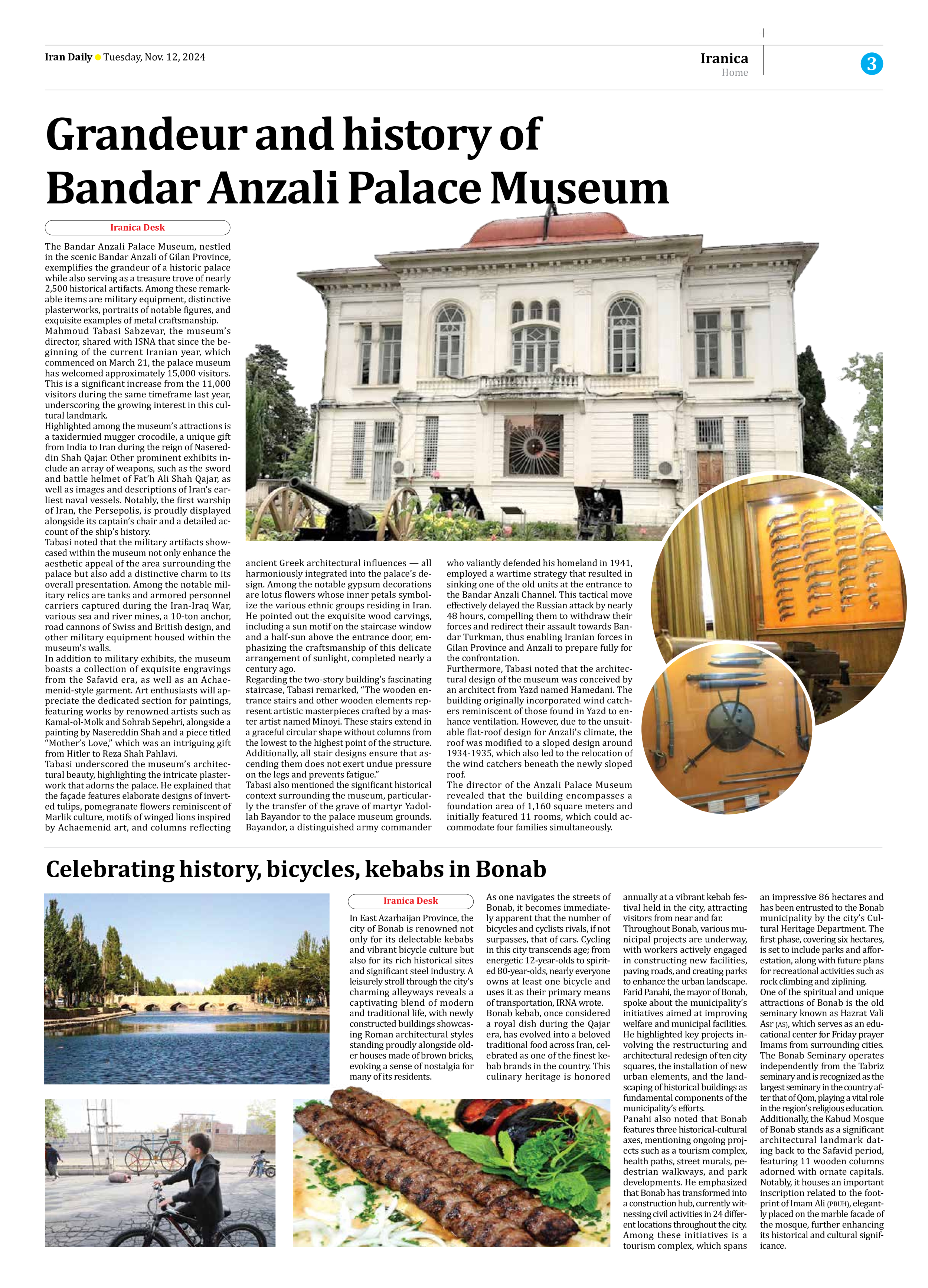
Grandeur and history of Bandar Anzali Palace Museum
The Bandar Anzali Palace Museum, nestled in the scenic Bandar Anzali of Gilan Province, exemplifies the grandeur of a historic palace while also serving as a treasure trove of nearly 2,500 historical artifacts. Among these remarkable items are military equipment, distinctive plasterworks, portraits of notable figures, and exquisite examples of metal craftsmanship.
Mahmoud Tabasi Sabzevar, the museum’s director, shared with ISNA that since the beginning of the current Iranian year, which commenced on March 21, the palace museum has welcomed approximately 15,000 visitors. This is a significant increase from the 11,000 visitors during the same timeframe last year, underscoring the growing interest in this cultural landmark.
Highlighted among the museum’s attractions is a taxidermied mugger crocodile, a unique gift from India to Iran during the reign of Nasereddin Shah Qajar. Other prominent exhibits include an array of weapons, such as the sword and battle helmet of Fat’h Ali Shah Qajar, as well as images and descriptions of Iran’s earliest naval vessels. Notably, the first warship of Iran, the Persepolis, is proudly displayed alongside its captain’s chair and a detailed account of the ship’s history.
Tabasi noted that the military artifacts showcased within the museum not only enhance the aesthetic appeal of the area surrounding the palace but also add a distinctive charm to its overall presentation. Among the notable military relics are tanks and armored personnel carriers captured during the Iran-Iraq War, various sea and river mines, a 10-ton anchor, road cannons of Swiss and British design, and other military equipment housed within the museum’s walls.
In addition to military exhibits, the museum boasts a collection of exquisite engravings from the Safavid era, as well as an Achaemenid-style garment. Art enthusiasts will appreciate the dedicated section for paintings, featuring works by renowned artists such as Kamal-ol-Molk and Sohrab Sepehri, alongside a painting by Nasereddin Shah and a piece titled “Mother’s Love,” which was an intriguing gift from Hitler to Reza Shah Pahlavi.
Tabasi underscored the museum’s architectural beauty, highlighting the intricate plasterwork that adorns the palace. He explained that the façade features elaborate designs of inverted tulips, pomegranate flowers reminiscent of Marlik culture, motifs of winged lions inspired by Achaemenid art, and columns reflecting ancient Greek architectural influences — all harmoniously integrated into the palace’s design. Among the notable gypsum decorations are lotus flowers whose inner petals symbolize the various ethnic groups residing in Iran. He pointed out the exquisite wood carvings, including a sun motif on the staircase window and a half-sun above the entrance door, emphasizing the craftsmanship of this delicate arrangement of sunlight, completed nearly a century ago.
Regarding the two-story building’s fascinating staircase, Tabasi remarked, “The wooden entrance stairs and other wooden elements represent artistic masterpieces crafted by a master artist named Minoyi. These stairs extend in a graceful circular shape without columns from the lowest to the highest point of the structure. Additionally, all stair designs ensure that ascending them does not exert undue pressure on the legs and prevents fatigue.”
Tabasi also mentioned the significant historical context surrounding the museum, particularly the transfer of the grave of martyr Yadollah Bayandor to the palace museum grounds. Bayandor, a distinguished army commander who valiantly defended his homeland in 1941, employed a wartime strategy that resulted in sinking one of the old units at the entrance to the Bandar Anzali Channel. This tactical move effectively delayed the Russian attack by nearly 48 hours, compelling them to withdraw their forces and redirect their assault towards Bandar Turkman, thus enabling Iranian forces in Gilan Province and Anzali to prepare fully for the confrontation.
Furthermore, Tabasi noted that the architectural design of the museum was conceived by an architect from Yazd named Hamedani. The building originally incorporated wind catchers reminiscent of those found in Yazd to enhance ventilation. However, due to the unsuitable flat-roof design for Anzali’s climate, the roof was modified to a sloped design around 1934-1935, which also led to the relocation of the wind catchers beneath the newly sloped roof.
The director of the Anzali Palace Museum revealed that the building encompasses a foundation area of 1,160 square meters and initially featured 11 rooms, which could accommodate four families simultaneously.







